| Listing 1 - 5 of 5 |
Sort by
|
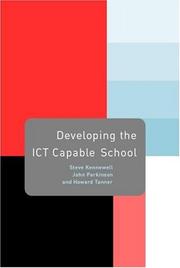
ISBN: 1134564732 1280401206 020313222X 0203170113 9780203170113 9780203132227 9780415235129 041523512X 9786610401208 6610401209 041523512X 9781134564682 9781134564729 9781134564736 9781138472396 1134564724 Year: 2000 Publisher: London RoutledgeFalmer
Abstract | Keywords | Export | Availability | Bookmark
 Loading...
Loading...Choose an application
- Reference Manager
- EndNote
- RefWorks (Direct export to RefWorks)
This book helps readers to improve the development of ICT capability through understanding the factors at work in whole school contexts. Based on research that examined schools' approaches to the development of pupils' ICT capability and identified the factors which lead to success, it provides practical advice, but with clear justifications in terms of well-researched principles and illustrations. It covers issues specific to both primary and secondary phases of education together with a range of common concerns and will be of use to practitioners and school staff involved in planning and del
Computer-assisted instruction. --- Information technology. --- Educational innovations. --- Education --- Innovations, Educational --- Technological change in education --- Educational planning --- Educational change --- Educational technology --- IT (Information technology) --- Technology --- Telematics --- Information superhighway --- Knowledge management --- CAI (Computer-assisted instruction) --- Computer-aided instruction --- Computer-assisted learning --- Computer based instruction --- Computer-enhanced learning --- Electronic data processing in programmed instruction --- ILSs (Integrated learning systems) --- Integrated learning systems --- Microcomputer-aided instruction --- Microcomputer-assisted instruction --- Microcomputer-assisted learning --- Microcomputer-based instruction --- Teaching --- Programmed instruction --- Innovations --- Technological innovations --- Experimental methods --- Data processing --- Computer assisted instruction
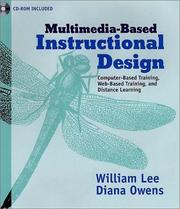
ISBN: 0787951595 Year: 2000 Publisher: San Francisco, Calif. Jossey-Bass/Pfeiffer
Abstract | Keywords | Export | Availability | Bookmark
 Loading...
Loading...Choose an application
- Reference Manager
- EndNote
- RefWorks (Direct export to RefWorks)
Computer-assisted instruction --- Employees --- Instructional systems --- #PBIB:2002.4 --- Instructional design --- Laborers --- Personnel --- Workers --- Persons --- Industrial relations --- Personnel management --- CAI (Computer-assisted instruction) --- Computer-aided instruction --- Computer-assisted learning --- Computer based instruction --- Computer-enhanced learning --- Electronic data processing in programmed instruction --- ILSs (Integrated learning systems) --- Integrated learning systems --- Microcomputer-aided instruction --- Microcomputer-assisted instruction --- Microcomputer-assisted learning --- Microcomputer-based instruction --- Teaching --- Education --- Educational technology --- Programmed instruction --- Telematics --- Training of&delete& --- Planning --- Design --- Data processing --- Computer assisted instruction --- internet --- onderwijs --- computerondersteund onderwijs --- Afstandsonderwijs. --- Internet. --- Multimedia. --- Onderwijstechnologie. --- Training of
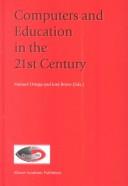
ISBN: 0792365771 9786610200191 1280200197 0306475324 9780792365778 Year: 2000 Publisher: Dordrecht ; Boston : Kluwer Academic Publishers,
Abstract | Keywords | Export | Availability | Bookmark
 Loading...
Loading...Choose an application
- Reference Manager
- EndNote
- RefWorks (Direct export to RefWorks)
ConieD is the biannual Congress on Computers in Education, organised by the Spanish Association for the Development of Computers in Education (ADIE). The last Congress, held in Puertollano (Ciudad Real), brought together researchers in different areas, ranging from web applications, educational environments, or Human-Computer Interaction to Artificial Intelligence in Education. The common leitmotiv of the major part of the lectures was the World Wide Web. In particular, the focus was on the real possibilities that this media presents in order to make the access of students to educational resources possible anywhere and anytime. This fact was highlighted in the Conclusions of the Congress following this Preface as the Introduction. From the full 92 papers presented to the Programme Committee we have selected the best 24 papers that we are presenting in this book. The selection of papers was a very difficult process, taking into account that the papers presented in the Congress (60) were all good enough to appear in this book. Only the restrictions of the extension of this book have limited the number of papers to 24. These papers represent the current high-quality contributions of Spanish research groups in Computers in Education. Manuel Ortega Cantero José Bravo Rodríguez Editors xiii Introduction ConieD’99 (1st National Congress on Computers in Education) has brought together a very important group of Spanish and Latin American researchers devoted to studying the application and use of computers in education.
Computer managed instruction --- Computer-assisted instruction --- Internet in education --- 720 Onderwijs --- 096 Informatica --- Internet (Computer network) in education --- CAI (Computer-assisted instruction) --- Computer-aided instruction --- Computer-assisted learning --- Computer based instruction --- Computer-enhanced learning --- Electronic data processing in programmed instruction --- ILSs (Integrated learning systems) --- Integrated learning systems --- Microcomputer-aided instruction --- Microcomputer-assisted instruction --- Microcomputer-assisted learning --- Microcomputer-based instruction --- Teaching --- Data processing --- 371.694 --- Education --- 371.694 Geprogrammeerde instructie. CAI. Leermachines. Computerbegeleid onderwijs. --- Geprogrammeerde instructie. CAI. Leermachines. Computerbegeleid onderwijs. --- Enseignement géré par ordinateur --- Enseignement assisté par ordinateur --- Internet en éducation --- Congresses --- Congrès --- EPUB-LIV-FT SPRINGER-B --- Education. --- Multimedia information systems. --- User interfaces (Computer systems). --- Educational technology. --- Learning & Instruction. --- Professional & Vocational Education. --- User Interfaces and Human Computer Interaction. --- Multimedia Information Systems. --- Educational Technology. --- Computers and Education. --- Data processing. --- Geprogrammeerde instructie. CAI. Leermachines. Computerbegeleid onderwijs --- Computer science. --- Multimedia systems. --- Learning. --- Instruction. --- Professional education. --- Vocational education. --- Education—Data processing. --- Instructional technology --- Technology in education --- Technology --- Educational innovations --- Instructional systems --- Computer-based multimedia information systems --- Multimedia computing --- Multimedia information systems --- Multimedia knowledge systems --- Information storage and retrieval systems --- Interfaces, User (Computer systems) --- Human-machine systems --- Human-computer interaction --- Education, Vocational --- Vocational training --- Work experience --- Technical education --- Education, Professional --- Career education --- Education, Higher --- Learning process --- Comprehension --- Aids and devices
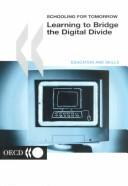
ISBN: 9264182888 9789264187764 9789264182882 9786610030798 1280030798 9264187766 Year: 2000 Publisher: Paris : OECD Publishing,
Abstract | Keywords | Export | Availability | Bookmark
 Loading...
Loading...Choose an application
- Reference Manager
- EndNote
- RefWorks (Direct export to RefWorks)
Across the OECD, attention is focusing increasingly on what has been dubbed the "digital divide" - a term that refers to the gaps in access to information and communication technology (ICT). The stakes are high, as ICT is now integral to the social fabric and is the catalyst for "new economies" to emerge. Exclusion threatens the ICT "have-nots", whether individuals, groups or entire countries. Political awareness of the stakes at issue grows sharply, as indicated by the prominence of the digital divide in G-8 discussions. Education and learning lie at the heart of these issues and their solutions. They are the lifeblood of our 21st century knowledge societies, and ICT is critical to them. The gaps that define the "learning digital divide" are thus as important as the more obvious gaps in access to the technology itself. Learning is central in the still more fundamental sense that the machines and equipment are useless without the competence to exploit them. Nurturing this competence is in part the job of schools and colleges, in part dependent on the learning that takes place throughout life in homes, communities, and workplaces. This volume meets an important need in the contemporary international literature on education policy, lifelong learning, and economic and social development. It presents analysis of the "learning digital divide" in different countries - developed and developing - and the policies and specific innovations designed to bridge it. The evidence shows that ICT can be the solution to inequalities rather than their cause - digital diversity and opportunity rather than digital divide.
Social problems --- Computer assisted instruction --- Digital divide --- Information technology --- Computers --- Information superhighway --- World Wide Web --- Internet --- Educational equalization. --- Fossé numérique --- Technologie de l'information --- Ordinateurs --- Autoroutes électroniques --- Web --- Démocratisation de l'enseignement --- Social aspects --- Aspect social --- Computer-assisted instruction --- Educational equalization --- Education --- 691 Informatiebeleid --- IT (Information technology) --- Technology --- Telematics --- Knowledge management --- Children --- Education, Primitive --- Education of children --- Human resource development --- Instruction --- Pedagogy --- Schooling --- Students --- Youth --- Civilization --- Learning and scholarship --- Mental discipline --- Schools --- Teaching --- Training --- Educational equality --- Educational equity --- Educational inequality --- Equal education --- Equal educational opportunity --- Equality of education --- Equalization, Educational --- Equity, Educational --- Inequality, Educational --- Opportunity, Equal educational --- Affirmative action programs in education --- Divide, Digital --- GDD (Global digital divide) --- Global digital divide --- Information society --- CAI (Computer-assisted instruction) --- Computer-aided instruction --- Computer-assisted learning --- Computer based instruction --- Computer-enhanced learning --- Electronic data processing in programmed instruction --- ILSs (Integrated learning systems) --- Integrated learning systems --- Microcomputer-aided instruction --- Microcomputer-assisted instruction --- Microcomputer-assisted learning --- Microcomputer-based instruction --- Educational technology --- Programmed instruction --- Effect of technological innovations on --- Aims and objectives --- Data processing --- Adult education. --- Computer-assisted instruction. --- Digital divide. --- Adults, Education of --- Education of adults --- Continuing education --- Open learning
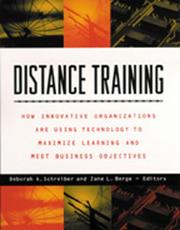
ISBN: 0787943134 1134580967 0203280539 1134580975 1280106182 0203165780 9780203165782 0415230659 9780415230650 9780415230667 0415230667 9786610106189 6610106185 9781134580972 9781134580927 1134580924 9781134580965 0415230667 9780787943134 9780203280539 9781280106187 Year: 2000 Publisher: London New York Routledge
Abstract | Keywords | Export | Availability | Bookmark
 Loading...
Loading...Choose an application
- Reference Manager
- EndNote
- RefWorks (Direct export to RefWorks)
Despite the massive potential of distance learning on the internet, the field of distance training is little known or understood. This guide addresses this knowledge gap and:*presents research into four models of distance education, into which it is claimed nearly all provision world-wide falls*provides a global overview of distance education and training *examines case studies of distance education establishments providing insight into their structure and advantages *challenges the premise that distance training lacks academic excellence and status *appraises the role
Distance education --- Occupational training --- Telecommunication in education --- Formation professionnelle --- Case studies. --- Cas, Etudes de --- Apprentissage Leerproces --- Changement Verandering --- Gestion des connaissances Kennisbeheer --- Matériel didactique Leermiddelen --- Objectifs (management) Doelstellingen (management) --- Technologie Technologie --- Education --- Job training --- Manpower development and training --- Manpower training programs --- Vocational training --- Training --- Education and training services industry --- Practice firms --- Distance learning --- Open learning --- Case studies --- Distance education. --- Computer-assisted instruction. --- World Wide Web. --- Employees --- Instructional systems --- Instructional design --- Laborers --- Personnel --- Workers --- Persons --- Industrial relations --- Personnel management --- W3 (World Wide Web) --- Web (World Wide Web) --- World Wide Web (Information retrieval system) --- WWW (World Wide Web) --- Hypertext systems --- Multimedia systems --- Internet --- CAI (Computer-assisted instruction) --- Computer-aided instruction --- Computer-assisted learning --- Computer based instruction --- Computer-enhanced learning --- Electronic data processing in programmed instruction --- ILSs (Integrated learning systems) --- Integrated learning systems --- Microcomputer-aided instruction --- Microcomputer-assisted instruction --- Microcomputer-assisted learning --- Microcomputer-based instruction --- Teaching --- Educational technology --- Programmed instruction --- Telematics --- Training of --- Computer network resources. --- Design. --- Data processing --- World Wide Web --- #PBIB:2002.2 --- Enseignement à distance --- Innovations technologiques --- Technologie éducative --- Enseignement à distance --- Technologie éducative
| Listing 1 - 5 of 5 |
Sort by
|

 Search
Search Feedback
Feedback About UniCat
About UniCat  Help
Help News
News